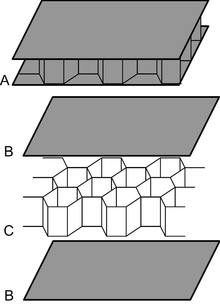Sandwich construction
In sandwich construction , materials with different properties are combined in layers to form a component or semi-finished product . The name comes from the also consisting of several layers snack called sandwich . The top layer-core-top layer sequence is typical.
Construction and statics
As a construction method, the sandwich construction designates a form of lightweight construction in which the components consist of force-absorbing solid cover layers that are held at a distance by a relatively soft, light, core material. These parts are very resistant to bending and buckling while being light. Their calculation is carried out in construction according to the linear sandwich theory .
The core can consist of solid material (polyethylene, balsa wood ), foam (rigid foam, metal foam ), insulation (rigid foam, mineral wool) or honeycomb lattice (paper, cardboard, metal, plastic). It transmits any shear forces and supports the surface layers. The heat and acoustic insulation properties of the very light core materials are often used. Sheet metal , (plywood) wood or fiber composite materials are used as top layers . Force introduction points are often provided with reinforcements.
Applications
Applications are, for example, sports boats, aircraft parts (fuselage, wing shells), railway wagons, surfboards (made of polyurethane ), and rotor blades for wind turbines.
Sandwich panels with a honeycomb core made of aramid fibers with outer layers made of glass fiber prepregs are often used as walls for galleys and toilets in aircraft.
Prefabricated sandwich panels consisting of a reinforced concrete supporting shell , thermal insulation and a facing shell made of clinker brick or concrete are used in construction. In addition, composite panels with metallic cover layers and an intermediate thermal insulation are referred to as sandwich elements or sandwich panels . Room doors are often made of plywood facings with a paper honeycomb core.
There are transparent sandwich elements for the roofs of production halls that let daylight through to illuminate the workplaces. This saves energy, as you can temporarily do without artificial lighting.
Ventilated façade plates for facade design and as rain protection consist partly of powder-coated or folienbeklebten 3 to 10 mm thick aluminum composite panels (engl .: aluminum composite panels, ACP). Panels of such facade systems can be bent with larger radii or, after removing a wedge from the material on the back, beveled. They are available in different fire classes from normally flammable to non-flammable, depending on the core material.
Advertising signs, billboards and large-format photos with high UV and weather resistance can be made from 3 to 10 mm thick aluminum composite panels with a dark brown polyethylene core material. They have names such as Alu-Dibond or Aluminum Composite Material (ACM). Printed or glued signs usually do not need a frame. Signs with photos or prints laminated on are suitable for dry locations.
The sandwich construction method is very common in shipbuilding , especially in sports boats . In the construction of large ships, the sandwich construction promises to bring more safety, especially for tankers . Existing ships can also be retrofitted.
In vehicle construction, exterior walls with thermal insulation in sandwich construction are used, among other things, in mobile homes and in the refrigerated box bodies of commercial vehicles.
In automotive engineering , the term sandwich construction is also used for a compact design in which the gearbox and the transverse engine, which is strongly inclined forwards, are partly under the floor of the front footwell. In the event of an impact, they do not penetrate the passenger compartment, but are pushed backwards under it. The entire front of the vehicle can be used as a crumple zone . In the double floor of the vehicle, reinforced by transverse and longitudinal members, there is space for the battery and the tank, among other things. Mercedes-Benz built the W 168 and W 169 , the first and the second A-Class , according to this principle .
Before the founding of the state of Israel, the Hagana , the forerunner of the Israeli army, converted trucks into so-called sandwich armored vehicles . They received superstructures made of wooden planks, which were covered with sheet steel on both sides.
In the manufacture of skis , the sandwich construction allows great variability in terms of material use and construction effort: the bandwidth ranges from simple foam core for beginner skis to small series for FIS World Cup skis with a glued wooden core.
Research is being carried out into a structure with metal foam as the core material for turbine blades .
In the aerospace sector, sandwich panels made of CFRP cover plates and an aluminum honeycomb core are used for the panels for the electronics. Some devices also have sandwich panels made exclusively of CFRP, as they are more torsion-resistant and lighter.





